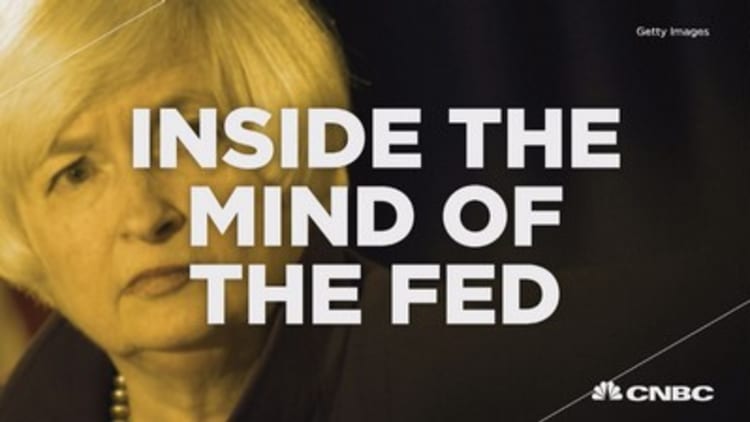
Investors hungry for clues about when the Federal Reserve is going to raise rates are looking for, well, anything.
That crowd includes one bond expert who has honed in on the word "some."
Yes, just four letters that make up one decidedly indefinite pronoun, contained in the Federal Open Market Committee's seemingly innocuous post-meeting statement Wednesday, could provide a key as to when the U.S. central bank finally will begin what should be a painstakingly slow exit from zero interest rates.
"By inserting the word 'some' before 'further improvement in the labor market' in the part of the FOMC statement that describes conditions needed for liftoff, the Fed effectively lowered the bar," Hans Mikkelsen, credit strategist at Bank of America Merrill Lynch, said in an analysis for clients. "While this is a hawkish tilt, clearly the subsequent rally in stocks and decline in interest rates suggest that the market expected—or should we say feared—more explicit language preparing for liftoff."
Mikkelsen filed his note Wednesday as stocks indeed were in rally mode. Market sentiment cooled somewhat Thursday as traders weighed what to make of the Fed statement against more news of an economy that has yet to find anything more than mediocre growth despite nearly seven years of supposedly stimulative monetary policy.
Gross domestic product grew 2.3 percent in the second quarter, according to the advance reading of the number released Thursday, while first-quarter growth was revised up but remained at an anemic 0.6 percent.
The specific part of the Fed statement that Mikkelsen referenced reads thus:
The Committee anticipates that it will be appropriate to raise the target range for the federal funds rate when it has seen some further improvement in the labor market and is reasonably confident that inflation will move back to its 2 percent objective over the medium term.
Those hardly seem the words of an ultra-dovish Fed about to bear down on monetary policy. But Mikkelsen considered adding the word "some" as an indication that Chair Janet Yellen and the rest of the FOMC don't need to see full employment and particularly strong wage gains above the current 2 percent annual pace in the increase of average hourly earnings.
Read MoreGross: Low rates are the problem, not the solution
While there weren't a lot of other Wall Street voices focusing on that specific word, the coalescence around a September hike seemed to come with similarly uncompelling evidence.
A number of economists seemed to think the first-quarter GDP revision all the way up to an uninspiring 0.6 percent was reason for tightening. Others thought a 2.9 rise in personal consumption expenditures would do the trick.
And never mind that overall measly 2.3 percent Q2 growth, said The Conference Board; the second half "will be better," the group contended, echoing a refrain heard multiple times since the beginning of zero interest rates and the expansion of the Fed balance sheet to $4.5 trillion.
In all that time, GDP has never posted full calendar-year growth exceeding 2.5 percent—2013 was revised all the way down from 2.2 percent to 1.5 percent—but, of course, this year will be different.
"Moving forward, we expect GDP growth to average close to 3 percent annualized in the second half of the year, due to a turnaround in mining and a fading impact from the dollar's appreciation," Steve Murphy, U.S. economist at Capital Economics, said in a note. "This should provide a decent base for economic growth of around 2.8 percent next year and support the case for higher interest rates sooner rather than later."
Read More GDP data mediocre, but Fed will raise anyway: Boockvar
Not everyone, however, is on board with September liftoff.
The CME's FedWatch tool that analyzes futures contracts pegs the probability of a September rate hike at zero percent, though it does indicate the funds rate will drift up from its current 0.14 percent to the top end of the Fed's preferred range, at 0.25 percent.
Matthew Hornbach, managing director and global head of interest rate strategy at Morgan Stanley, also examined the "some" factor and concluded it's unlikely that alone is an indicator the Fed will move. He believes the FOMC will need to see at least two more months of 200,000-plus nonfarm payrolls creation and confidence that inflation is moving toward 2 percent before announcing liftoff.
"While the FOMC statement said that only 'some' further labor market progress was needed prior to liftoff, we do not think that upcoming economic data will cause investors to raise the odds of a September liftoff," Hornbach said in a note to clients.






